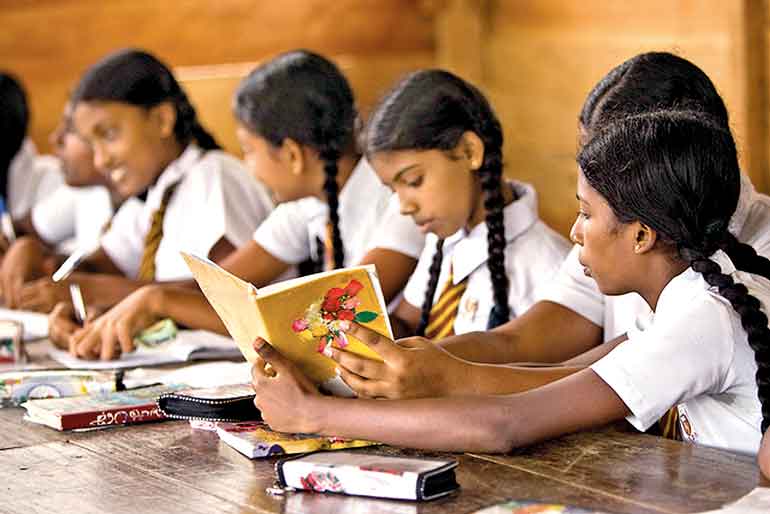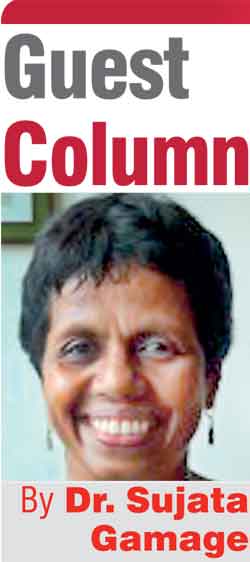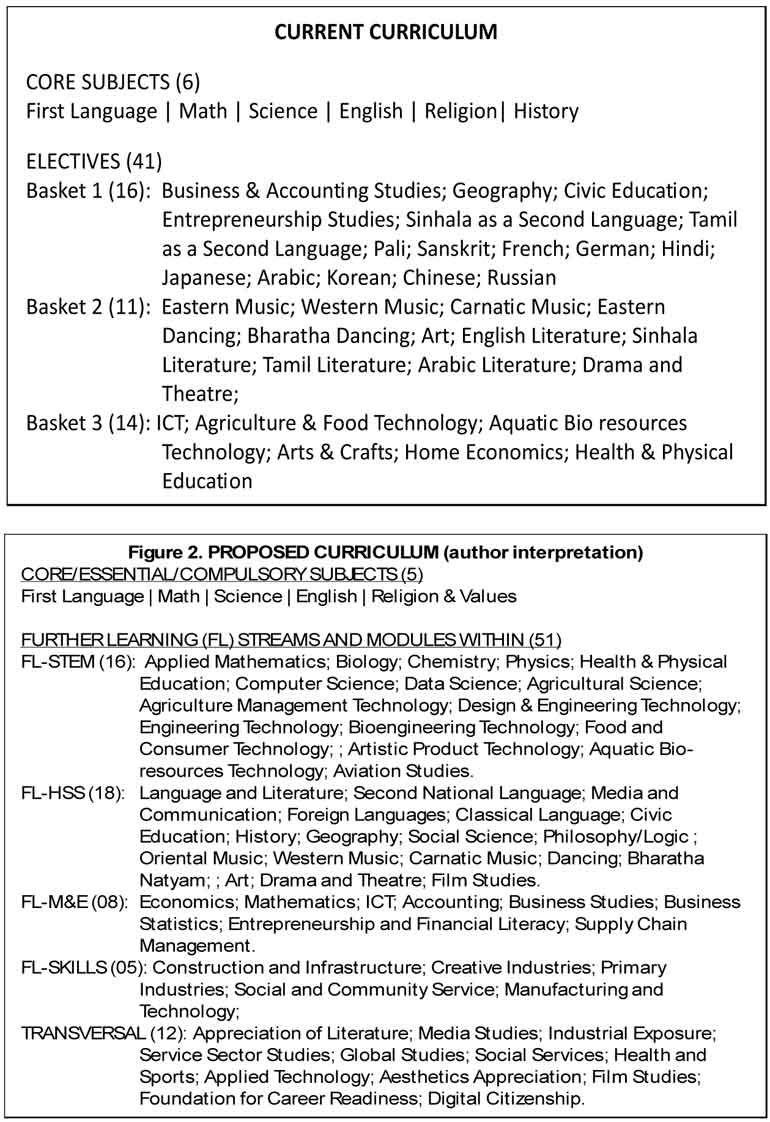Wednesday Dec 24, 2025
Wednesday Dec 24, 2025
Tuesday, 19 August 2025 00:00 - - {{hitsCtrl.values.hits}}

At first glance the new content seems heavier and more complex. Do the drafters have any idea of how schools manage?
The Ministry of Education, Higher Education, and Vocational Education (MoE) has unveiled what they call a major reform agenda to reshape the future of Sri Lankan education, titled Transform Education: Transform Sri Lanka, in the Parliament of Sri Lanka on 11 July 2025.
The reform agenda has been presented as a PowerPoint and a PowerPoint only, a first for such an important reform agenda in the history of Parliament, if I am not mistaken. Whatever the format, we should be grateful to the present Government and the Minister for Education for giving leadership at this time to a stalled curricular reform process.
 However, unveiling of this PowerPoint is really a non-event, in my opinion. As noted in the presentation, these curricular reforms have been ongoing since 2019 or before. The impact of the reforms will not be felt until 2029 and the full impact not until 2031. The textbooks and teacher guides have already been printed and piloted for implementation in Grades one and six, respectively, for 2026. A ceremony to give the blessing of the Government and a progress report at the end of one year would have been more appropriate.
However, unveiling of this PowerPoint is really a non-event, in my opinion. As noted in the presentation, these curricular reforms have been ongoing since 2019 or before. The impact of the reforms will not be felt until 2029 and the full impact not until 2031. The textbooks and teacher guides have already been printed and piloted for implementation in Grades one and six, respectively, for 2026. A ceremony to give the blessing of the Government and a progress report at the end of one year would have been more appropriate.
Non-event or not, the whole country is engaged in animated discussions with only a PowerPoint in hand. In the past few days, I too have been asked to comment on new education reforms, and I have been responding as best I could, confident with the background information to which I was privy as a member of a sub-committee to draft the interim report and subsequently a member of the committee to implement the National Education Policy Framework 2023-2033 of the previous regime.
As I went into details of the present reform, I was happy about the proposals for assessments, but the content left me deeply worried. The present content includes six essential subjects offered as school-wide as 10 subjects, and 41 elective subjects organised as three baskets (Figure 1).
In the new curriculum new terms are used willy nilly. After the jumble of terms is sorted with great difficulty, the new curriculum offers five essential subjects and 49 ‘modules’ which are grouped under the headings STEM, HSS, M&E, SKILLS and TRABSVERSAL SKILLS. With the first three been acronyms for Science, Technology, Mathematics and Engineering; Humanities and Social Sciences; and Management and Entrepreneurship, respectively. (Figure 2).
At first glance the new content seems heavier and more complex. Do the drafters have any idea of how schools manage? As one former principal remarked – you can label the subjects Essential, Elective or Further Learning, but we teach what the available teachers can teach.
In this column I plan to start with the positives in the assessments before getting down to a critique of the content.
1.Assessments – Transformative
Two most significant changes proposed are (1) an assessment of literacy, numeracy and skills in Grade nine and (2) a new cumulative credit system leading to a GPA or a Grade Point Average for Grades 10-11. It appears that a school-based certificate of completion with the cumulative GPA will be offered in parallel to the one-time ABC letter-grade result given in the GCE O/L examination.
Parents are increasingly opting for international schools providing education in the English medium and an assessment in English is a good way to shape up the teaching of English in government schools and encourage families to stay in the public system which they are maintaining with their tax rupees
Literacy, numeracy, and skills assessment in Grades Nine long overdue
This assessment of literacy and numeracy will not only give students an understanding of their capabilities but also fulfil the country’s obligation for the SGD indicator 4.4.1 which is “Proportion of children and young people (a) in grade 2/3; (b) at the end of primary; and (c) at the end of lower secondary achieving at least a minimum proficiency level in (i) reading and (ii) Mathematics, by sex.”
Going forward, we need similar assessments in Grades Five and Eleven as well, minimum proficiency in English included in all assessments.
Parents are increasingly opting for international schools providing education in the English medium and an assessment in English is a good way to shape up the teaching of English in government schools and encourage families to stay in the public system which they are maintaining with their tax rupees.
Maintaining a GPA system parallel to the GCE O/L is progressive and realistic
Proposal for a GPA system has been discussed in the education sector for over a decade. The first mention of the use of a GPA system is in a research study commissioned by the National Education Commission (NEC) in 2014.
A GPA (Grade Point Average) can be a more comprehensive indicator of academic performance than a single written exam like GCE (O/L) because it reflects a student’s performance across multiple subjects and over a longer period. While the GCE O/L is the outcome of a onetime summative examination, a GPA considers a student’s overall academic record, including coursework, assignments, and participation, providing a more holistic view of their abilities and potential.
Currently, students who fail to get the requisite passes at the GCE O/L do not get any credit for their time they spend learning at school and completing at least some of the modules/assignments successfully. Further, even those who succeed may waste 8-10 months waiting for the GCE O/L exams to be held, results released, and A/L classrooms cleared.
With a GPA system all students should be able to move from Grade 11 to 12 smoothly.
Secondary certificate for all is more realistic than NVQ-4 for all
Promising to give an NVQ-4 qualification to everybody who does not pursue higher education is grossly misleading. An NVQ is awarded to those who demonstrate competency according to a skill standard for a specific vocation. The Tertiary and Vocational Education Commission, of which I was the Director General for a brief period during 2003/2004, awarded 49,967 NVQ-4 certificates in 2024. If we are to give an NVQ-4 to every student who does not go to university, we are looking at about 250,000 or more school leavers being awarded NVQ certificates. Even if we manage to award that number of NVQ certificates, what is the demand for specific vocational skills? Besides, it is well established that all students should receive a general education with essential skills before they seek vocational training.
GCE (O/L) exam can be a personal choice, not a requirement
It is not explicitly stated, but if a completion certificate with a GPA and a breakdown of grades by modules, is given at the end of grade eleven, the GCE O/L would serve only as an affirmation of the same. Even now students can proceed to a vocational track in Grades 12-13 without GCE (O/L) requirements but vocational courses outside of school still require certain O/L qualification. A Certificate of Completion of Senior Secondary I (Grade 10-11) would be a relief to vocational training seekers.
Those seeking an academic track in Senior Secondary II (G 12-13) may need to sit only for the subjects they need for their further education, since they too would have a Certificate of Completion of Senior Secondary II (Grades 12-13), when reforms are completed in 2031. In fact, this is the practice in USA where the GPA in completion certificate awarded by the school is used to assess student performance and students take Advance Placement Test carried out by a recognised national entity for the subjects they need for their chosen course of higher study.
Assessing the core subjects remains unfair and a one-size-fits-all affair
The individuals in any given cohort of students would have a wide range of abilities. For example, some would be strong in academic subjects but weak in practical aspects. Others would be weak in academic subjects and stronger in practical aspects.
The present set of essential subjects is offered as a one-size-fits-all one where all students follow the same material and face the same assessment. The proposed curriculum does not correct for that.
Highly regarded curricula are offered at two or more levels of demand. For example, to earn an International Baccalaureate diploma a student needs to take six core subjects with at least three at a higher level and the rest at a standard level.
The latest curriculum reforms in Singapore which were effective from 2024, give student the option for following any given subject at three different levels of demand.
A GPA (Grade Point Average) can be a more comprehensive indicator of academic performance than a single written exam like GCE (O/L) because it reflects a student’s performance across multiple subjects and over a longer period. While the GCE O/L is the outcome of a onetime summative examination, a GPA considers a student’s overall academic record, including coursework, assignments, and participation, providing a more holistic view of their abilities and potential. Currently, students who fail to get the requisite passes at the GCE O/L do not get any credit for their time they spend learning at school and completing at least some of the modules/assignments successfully
2.Content – Problematic
The primary and junior secondary curriculum in the NCF-2025 makes somewhat sense, but the Senior Secondary I (Grades 11-12) curriculum is impossible to decipher.
As mentioned, currently students are required select six essential or core subjects from a list of 10 subjects which offer Sinhala or Tamil as first language options, and Buddhism, Hinduism, Islam, Christianity, and Catholicism as religion options. Further, students choose three electives from three baskets containing 16, 11, and 14 subjects, respectively, for a total of 41 electives. Altogether the department of examination needs to offer 51 subjects annually for the GCE (O/L) examination. The terminology is limited to two types of subjects -essential or core and elective.
Jumble of terminology
In the new curriculum there is a jumble of terminology such as – Subjects v. Modules; Core/Essential/Compulsory subjects v. Electives, Further-Academic and Further-Skills modules and Transversal skills with no explanations.
A way out of the jumble
All further learning modules are listed under the four streams – STEM, HSS and M&E & SKILLS, and the first three streams are given a combined heading of “Further Learning Academic Path” the fourth Skills stream given the heading “Further Learning Skills Path”.
In effect, the STEM, HSS and M&E streams are academic paths, and the SKILLS stream is, well, a Skills path, making the Academic v. Skills distinction meaningless.
Once you remove the redundant Academic/Skills distinction what we have in the new curriculum is a set of modules organised along four streams of study and Transversal Skills (Figure 2).
Transversal Skills presumably are to be acquired though co-curricular activities sports, clubs, and communities service or work-related projects in the school. The ‘Modules’ under the transversal skills have headings like Media Studies; Service Sector Studies; Global Studies; Film Studies etc., which one might include under Further Learning Modules under the HSS stream.
To add to the confusion, nineteen ‘Subjects’ with the same headings as those in the Further Learning Steams are listed as Electives. Clearly the drafters are trying to impose GCE (O/L) requirements into a new GPA system and muddying the water in the process.
One way out of this jumble is to first consider the requirements for a new school-based GPA system of assessments and then consider the GCE (O/L) requirements a separate matter.

3.Recommendations
Clarify requirements for a school-based certificate of completion with GPA
After wading through the jumble of confusing terminology for Grades 10-11, we find that all that the new curriculum essentially renames BASKETS of subjects in the current curriculum with a set of four STREAMS – as STEM, HSS, M&E and SKILLS. This list of modules is too long. How would a principal of a school with, say, teacher shortages, deal with this kind of list?
Drafters need to go back to drawing board and rationalise and reorganise this list of forty-one modules. There are indications that the drafters were influenced by the Finnish system õfyf¾ f;a pq¾ßpq¨ï curriculum organised Topics or Themes ú;a no subjects. They should rethink and re-learn from aspirational but more down-to-earth curricula like those offered by the IB Diploma or the new 2024 Singapore Curriculum.
Clarify requirements for an optional GCE (O/L) Certificate/s
The drafters should treat the GCE O/L requirement as a separate matter. The Department of Examination could offer the same number of six subjects they do now with new headings such as – First Language, Math, Science, English, Religion and Values, and History and Social Studies.
It would be the responsibility of the NIE to map the modules to the subjects offered by the DoE.
For example, a student who wishes to take history as a subject for his/her GCE O/L may be required to take two designated further modules in history. The new curriculum does not offer history at an essential competencies level. Implicit in this exclusion is the understanding that competencies covered in Grade 6-9 are sufficient to study further learning modules of History in Grade 10-11.
Remove obstacles to the freedom of choice for students, not add
Whatever changes are made, the focus should be on giving students the freedom to choose and not slot them too early in their schooling.